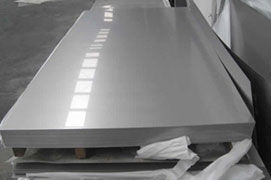The performance and application of 316 stainless steel plate
- Wilson Pipeline
- Jan 5, 2022
- 3 min read
The chemical composition of 316 stainless steel plate is mainly of the phosphorus, which is less than 0.035%, or 0.03% sulfur, 10.0-14.0% nickel, 16.0-18.5% chromium, 2.0-3.0% molybdenum element. The performance is also good, the tensile strength (Mpa) 620 MIN, yield strength (Mpa) 310 MIN, elongation (%) 30 MIN, area reduction (%) 40 MIN, the density is 8.03 g/cm3.

316 stainless steel plate by adding alloying elements molybdenum, so its corrosion resistance, resistance to atmospheric corrosion resistance and high temperature strength is especially good, can be used in harsh environment, the work hardening performance good, also has good high temperature strength, products of nonmagnetic solid solution state, another glossiness good appearance of the cold rolled sheet but its price is higher compared with 304 stainless steel. It is mainly used to make seawater or highly corrosive environment.
The 410 stainless steel plate, as the representative steel of martensitic steel, is not suitable for application in strict corrosive environment, although the strength is high. Its processing performance is excellent, the main purpose is knife edge, machine part, oil scouring device, bolt, nut, pump rod, 1 kind of tableware.
Difference between 316 stainless steel plate and 410 stainless steel plate
Daily use of the most stainless steel model is 304, 316 stainless steel, the main difference is that in the chemical composition of the two 316 molybdenum, and broad consensus is 316 stainless steel corrosion resistance is better, more than 304 under the environment of high temperature corrosion resistance. Therefore, 316 stainless steel components are usually used in high-temperature operating environments.
However, there are exceptions. In the sulfuric acid environment, the high temperature can not be made of 316 stainless steel. Otherwise there will be big problems. Learn machinery are studied thread, remember to prevent thread killed below high temperature circumstance, need to apply a black solid lubricant, the molybdenum disulfide (MoS2), it has two conclusions, first of all, molybdenum is a kind of high temperature resistant material, such as molybdenum crucible is gold in the crucible of molten, second molybdenum easily and high reaction generated sulfide sulfur ions. So no stainless steel can withstand any corrosion. At the end of the day, stainless steel is a piece of impurity steel, although it is more resistant to corrosion than normal steel, but it can react with other materials as long as it is steel.
316 stainless steel plate is a lot of more phyletic, mainly pided into polished stainless steel plate, light stainless steel plate, precision surface of stainless steel plate, stainless steel plate, 6 k BA surface of stainless steel plate, 2 b surface of stainless steel plate, surface of stainless steel plate, 8 k mirror stainless steel plate, ultra-thin stainless steel plate, in the thick thick stainless steel plate, stainless steel plate, super thick stainless steel plate.
Thickness of stainless steel plate: thin plate (0.2mm- 4mm), medium plate (3mm- 30mm), thick plate (4mm- 60mm), special thickness plate (60-115mm).
With the development of economy, the use of 316 stainless steel plate is also more and more, in our daily life is closely related to stainless steel, but a lot of people know the performance of the stainless steel is not much, maintenance of 316 stainless steel plate and seldom know. Not familiar with the people think that stainless steel is never rust, actually, is only good corrosion resistance of stainless steel, the reason is that the surface form a layer of passivation film, it is in the nature exists in the form of more stable oxide. In other words, although the stainless steel is different depending on the conditions of use, the oxidation degree is different, but it is eventually oxidized. This phenomenon is usually called corrosion. The exposed metal surfaces in the corrosive environment all have electrochemical reactions or chemical reactions, which are corroded uniformly.
316 stainless steel plate surface corrosion resistance of passivating film weak parts, also on self-excited pitting, formed by the reaction, resulting in holes, add to the chloride ion have close, can produce very strong corrosive solution, the speed of the accelerated corrosion reaction. In addition, the corrosion cracking of intergranular corrosion in stainless steel can destroy the passivation film on the surface of the stainless steel plate. Therefore, the stainless steel surface must be regularly cleaned and maintained, which will keep the stainless steel plate beautiful and extend the service life.
Source: China Stainless Steel Plate Manufacturer – wilsonpipeline Pipe Industry Co., Limited (www.wilsonpipeline.com)

Comments